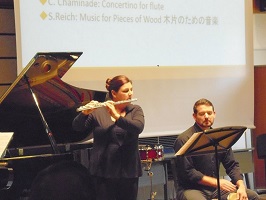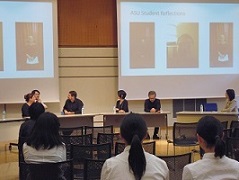Report of International Symposium 2017
Report of International Symposium, Gunma University ・Muse Hall ・Aramaki Campus, Sunday, October 1, 2017 ・13:30-16:00
Music × Art × International Exchange with Dr. Tracy K. Doyle and Dr. James W. Doyle III From Adams State University, Colorado, USA
On October 1, 2017 an international symposium organized by Gunma University School of Arts and Sciences was held at Aramaki campus’s Muse Hall auditorium. As the central part of this event, Gunma University was honored to receive special guests, Dr. Tracy K. Doyle and Dr. James W. Doyle III from Adams State University, Colorado, USA. This symposium was co-sponsored by Gunma University Research Institute for Long-Term Music Education and Training and Gunma University International Center.
At the start of the event, Professor Tracy Doyle introduced the music department of Adams State University. In her remarks, Professor Doyle commented that her focus is on providing music education training to small regional universities and provide the type of training that helps to promote awareness of ‘Equity’ rather than ‘Equality’ in the study of music.
Associate Professor, Chiho Sugo presented the second keynote lecture. In her talk, which was based on a five-month training period at Adams State University, Professor Sugo shared her experience of discovering that the “living arts” are deeply rooted in the local community. Following the lecture, the audience was treated to a musical performance that included a variety of musical instruments such as the flute, percussion, piano, and clarinet.
Although the audience included individuals from different cultures and languages, sharing music together created a magical space where all participants became one. The event became a special occasion where collaboration, harmony and creativity helped to bring a deeper meaning to the definition of international exchange.
In the panel discussion that followed the lectures and musical performance, events such as the Nakanojo Biennale Contemporary Art Festival were discussed as a positive way for artists to contribute to the community through their artwork and creative activities. Thanks to the contribution of many, the event became a very meaningful symposium.





